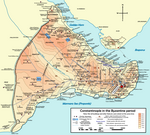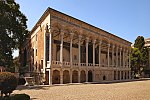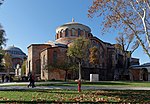Column of Leo

The Column of Leo was a 5th-century AD Roman honorific column in Constantinople. Built for Leo I, Augustus of the East from 7 February 457 to 18 January 474, the column stood in the Forum of Leo, known also as the Pittakia. It was a marble column, without flutes, composed of drums with a Corinthian capital, surmounted by a statue of the emperor.The column no longer exists, but fragments belonging to it were discovered in the mid-20th century in the grounds of the Topkapı Palace, including the capital and the impost block atop it, a complete column drum and some parts of a second, and the statue's pedestal, which was originally separated from the impost by a missing plinth. The remains are visible in the second courtyard of the Topkapı complex. The column's own socle, pedestal, and base are lost. The statue too may be lost, or it may be the bronze statue now known as the Colossus of Barletta in Italy.
Excerpt from the Wikipedia article Column of Leo (License: CC BY-SA 3.0, Authors, Images).Column of Leo
Courtyard of the Eunuchs, Istanbul
Geographical coordinates (GPS) Address Website Nearby Places Show on map
Geographical coordinates (GPS)
| Latitude | Longitude |
|---|---|
| N 41.013276 ° | E 28.984825 ° |
Address
Topkapı Sarayı
Courtyard of the Eunuchs
34122 Istanbul
Türkiye
Open on Google Maps









